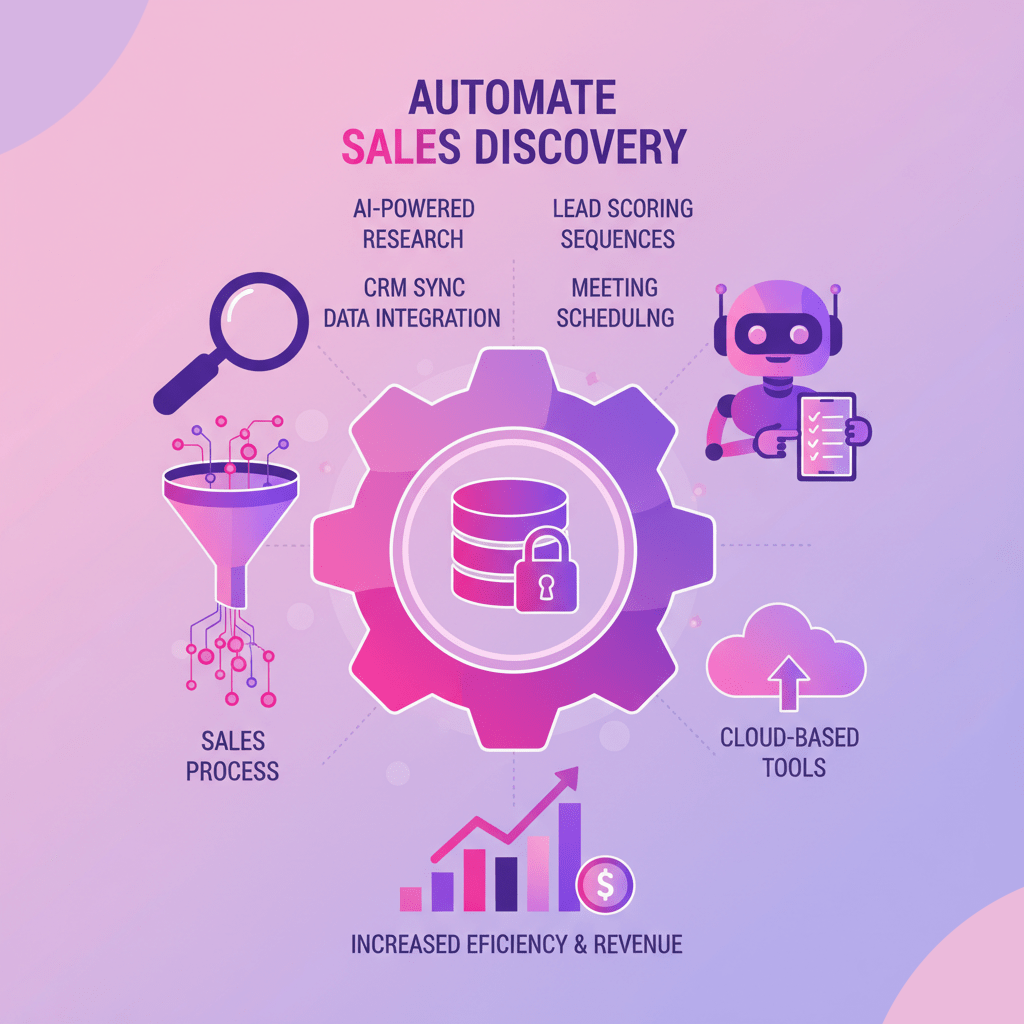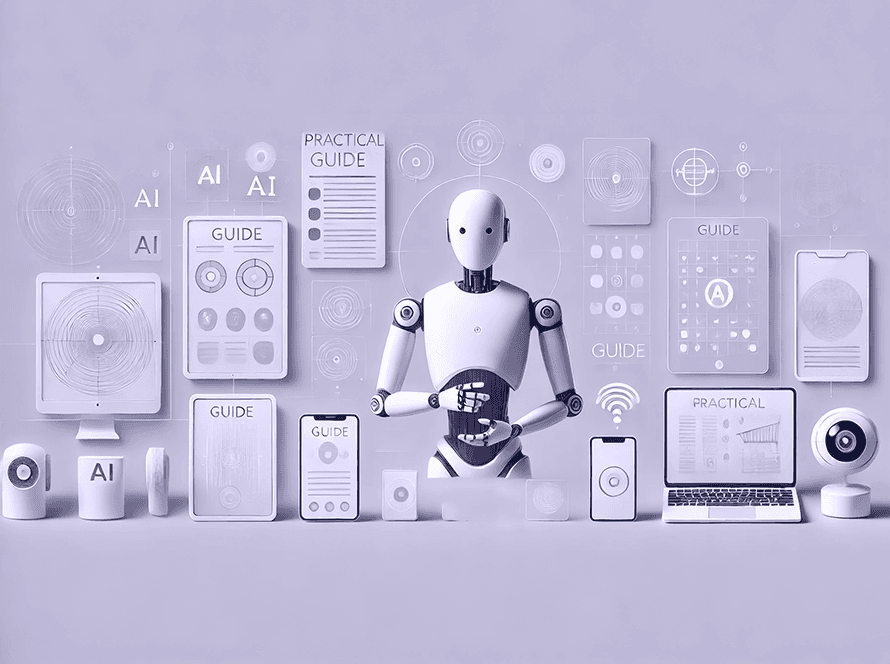“Learn How to Automate the Sales Discovery Process using conversational AI for qualification, saving AE time, and delivering a personalized, high-value first call every time.”
You’ve seen it. Your star Account Executive (AE) has a calendar packed, back-to-back, with “discovery calls.” They’re hustling. They’re busy. However, by the end of the quarter, the numbers aren’t there.
Why?
You shadow a few calls, and the problem becomes painfully clear.
- Call 1: The prospect is a “tire-kicker.” They have no budget, no authority, and are just “doing research.” The AE spends 45 minutes on a call that should have been an email.
- Call 2: The prospect is a decent fit, but the AE spends the entire call just asking basic questions. “What’s your current solution?” “What’s your timeline?” “Who needs to sign off on this?” By the time they get the basics, the meeting is over. There was no time for a strategic demo or a deep, value-driven conversation.
- Call 3: The prospect is perfect. But they’re frustrated. They already gave all this information to the BDR who booked the meeting. Now they’re repeating themselves. The rapport is broken before it even begins.
This is the hidden bottleneck that silently strangles sales organizations. Your most expensive, highly-skilled closers are spending 80% of their time on low-value, repetitive qualification instead of what they do best: closing deals.
For years, we’ve been told there are only two solutions, and both are bad:
- Manual Hell: Keep doing what you’re doing. Burn out your AEs. Accept a leaky funnel and an inefficient, high-cost sales process.
- Automation Purgatory: “Fix” it with automation. Send prospects a 20-question web form. Use a clunky, rules-based chatbot. You’ll qualify leads before discovery calls, sure, but you’ll also kill the human connection. You’ll save your AEs’ time, but you’ll also bore your best prospects into ghosting you.
This is a false choice.
You can have both. You can automate the sales discovery process and make the experience more personal, not less. The secret isn’t just technology; it’s a new philosophy called “Structured Discovery.”
This guide will break down the process of designing this. We’ll show you how to identify the essential questions you must automate and how to leave the deep-dive personalization for your AEs. Then, we’ll introduce the technology, such as SalesCloser.ai, that finally masters this delicate balance, utilizing conversational AI to emulate a human touch while running a ruthlessly efficient qualification workflow.

The Core Problem: Why Your “Human-Only” Discovery is Failing
Before we discuss automation, we must be brutally honest about why the traditional, 100% human-led discovery process is so flawed. We romanticize the “art of the sale” and the human touch, but we ignore the very human flaws that come with it.
1. Your AEs are Expensive “Information Collectors”
Think about your AEs’ hourly cost (salary, commission, benefits, training). Every minute they spend asking a question that could have been answered in an email is a dollar burned.
The job of an AE should be to synthesize information, challenge a prospect’s assumptions, and build a vision for a solution. Their job is not to be a human data-entry clerk, asking “What’s your budget?” and “What’s your timeline?” five times a day.
When you force your AEs to handle 100% of discovery, you’re not “adding a human touch.” You’re fundamentally misusing your most valuable asset. This is the single most significant drain on sales process efficiency.
2. Humans are Wonderfully, Terribly Inconsistent
Your top-performing AE, “Closer Chris,” has a mental checklist of 10 questions he asks on every call. He’s a machine. Your new AE, “Newbie Ned,” is still getting accustomed to the role. He asks three questions and then jumps straight into a rambling demo.
The result? The qualification data in your CRM is a mess.
- Chris’s notes are perfect.
- Ned’s notes are missing budget, authority, and timeline.
- Sarah’s notes focus only on the prospect’s pain points but miss all the “BANT” criteria.
You can’t forecast. You can’t build reports. You can’t analyze which leads actually turn into customers because the data you’re collecting is wildly inconsistent. It all depends on which rep got the call and what kind of day they were having. This lack of standardization is a silent killer.
3. The Prospect Hates Repeating Themselves
Here is the journey of a modern B2B buyer:
- They fill out a “Request Demo” form.
- They get an automated email from an SDR.
- They email back and forth with the SDR to find a time.
- They have a 15-minute “qualifying call” with the SDR, where they explain their needs, budget, and timeline.
- The SDR “approves” them and books a new call with an AE.
- They join the call with the AE… who opens with, “So, tell me a bit about your business and what you’re looking for.”
This is madness. The prospect is screaming into the void, “I ALREADY TOLD YOUR COMPANY THIS!” It’s an experience filled with friction. It makes your company look disorganized and disrespectful of the prospect’s time.
The goal isn’t just to gather qualifying information upfront; it’s to collect it once and make sure it’s passed seamlessly to the next person.
The Solution: The “Structured Discovery” Framework
The answer isn’t to stop doing discovery. It’s to split it.
We need to create two distinct stages:
- Stage 1: Structured Discovery (The “What” and “Who”)
- This stage is automated.
- Its sole purpose is to gather the 5-7 foundational, non-negotiable data points.
- This is the “table stakes” info you need to know if a call is even worth an AE’s time.
- Stage 2: Strategic Discovery (The “Why” and “How”)
- This stage is 100% human, led by your AE.
- Because Stage 1 is complete, the AE doesn’t waste time on basics.
- They use their time to explore nuance, build rapport, and challenge the prospect.
This is pre-discovery automation. The goal is straightforward: standardize and automate repetitive discovery questions. This saves your AEs’ time, not to replace them, but to unleash their full potential.
How to Find Your “5-7 Magic Questions”
This is the most critical step. You need to get your sales and marketing leaders in a room and refuse to leave until you’ve defined these questions.
Step 1: Get the Right People in the Room. This includes your VP of Sales, your top 2 AEs, your top SDR, and a marketing leader. You need the “in the trenches” perspective and the high-level strategic view.
Step 2: Start with a “Brain Dump.” Ask the group: “What are all the things we could ask a prospect?” You’ll get 30-40 questions.
- What’s your role?
- Company size?
- Industry?
- Current solution?
- Why are you looking now?
- What’s your budget?
- Who is the decision-maker?
- What are your top 3 pain points?
- What’s your timeline?
- What metrics do you care about?
- Etc…
Step 3: Filter Through a Qualification Framework. Now, get ruthless. You can’t automate 30 questions. You need to find the 5-7 essentials. The most effective way to do this is by utilizing a proven sales qualification framework.
Don’t debate frameworks; just use them as a filter.
- Using BANT (Budget, Authority, Need, Timeline):
- Need: What is the single biggest challenge you’re trying to solve? (1 question)
- Authority: Besides yourself, who else is involved in the final decision-making process? (1 question)
- Budget: To ensure we’re on the right track, what budget have you allocated for this project? (1 question)
- Timeline: What’s your ideal timeline for implementing a new solution? (1 question)
- Using MEDDIC (Metrics, Economic Buyer, Decision Criteria, Decision Process, Identify Pain, Champion):
- Identify Pain: What’s the primary problem you’re hoping to solve? (1 question)
- Metrics: How do you currently measure success for this? (1 question)
- Economic Buyer: Who holds the budget for this purchase? (1 question)
- Decision Process: What does your typical evaluation process look like for new software? (1 question)
You’ll notice BANT and MEDDIC overlap. Your “Magic 5-7” will likely be a hybrid. For most B2B companies, it looks something like this:
- The Core Pain: “What’s the main challenge you’re facing with [Your_Problem_Area] right now?”
- The “Why Now”: “What’s driving the need to solve this now versus 6 months from now?”
- The Authority: “Who else on your team will be involved in evaluating and approving this?”
- The Budget: “To respect your time and ours, could you share the rough budget you’ve set aside for this?”
- The Timeline: “What’s your ideal launch date?”
- The Deal-Breaker: “What’s your current solution, and what’s the one thing it doesn’t do that you need?”
Step 4: Standardize and Commit. These 5-7 questions become your Structured Discovery script. Everyone in the sales org commits to this. This is your new “Definition of a Qualified Lead.”
An AE should never have to ask these questions again. Their job starts after these are answered. This is how you improve discovery call quality overnight. The call begins with, “Hi John. I’ve reviewed your notes. I see you’re struggling with X, need to launch by Q3, and are evaluating us against Y. Let’s dive right into how we can solve X.”
Imagine that—a whole discovery call dedicated purely to value, not interrogation.
This Isn’t Your Dad’s Chatbot: How to Automate Without Being a Robot
So you have your 5-7 questions. How do you ask them?
The Old Way (And Why It Fails):
- A Static Web Form: You replace your “Demo Request” button with a 7-question form.
- The Result: Your conversion rates plummet. No one wants to fill out a test just to talk to a salesperson. It’s high-friction, impersonal, and has a 0% chance of building rapport.
The New Way: Conversational AI This is where the game changes. Modern AI isn’t just a “chatbot.” It’s a “Conversational Sales Agent.” It’s designed to do one thing: execute your Structured Discovery script in a way that feels natural, empathetic, and personal.
This is precisely what a tool like SalesCloser.ai is built for. It masters the balance between automation and personalization.
Here’s how it works in practice.
1. It’s Proactive and Instant
A lead visits your pricing page and fills out a “Contact Sales” form. Their “intent” is at its absolute peak.
- The Old Way: The lead gets an email that says, “Thanks! An SDR will be in touch in 24-48 hours.” By then, the lead is busy, has lost interest, or is already talking to your competitor.
- The SalesCloser.ai Way: Instantly, a conversational AI engages the lead, right on your site or via text/email. It says, “Hi [Name]! Thanks for reaching out. I’m the AI assistant for the sales team. I can get you booked with the right expert right now. I just need to ask a few quick questions to make sure we’re prepared for your call. Sound good?”
You’re qualifying the lead while they are live and at their highest point of interest.
2. It Weaves Personalization into the Script
This is the most crucial part. Automation doesn’t have to be cold. Effective conversational AI is scripted to convey empathy and utilizes data to establish rapport.
Let’s say your lead, John, from “Acme Corp” (a logistics company), just signed up.
- A Bad Chatbot: “What is your budget?”
- SalesCloser.ai (with personalization): “Great, thanks, John. We work with many great logistics companies, such as Acme Corp, and I want to ensure that I connect you with our industry specialist. To make that call as valuable as possible, could you provide me with a rough estimate of the budget you’re working with for this project? It just helps us frame the solution correctly.”
See the difference?
- It used his name (“John”).
- It referenced his company and industry (“Acme Corp,” “logistics companies”).
- It explained why it was asking the question (“to connect you with our industry specialist”).
- It was polite and natural (“rough idea,” “helps us frame”).
This single interaction achieves three things at once:
- It gathers the crucial “Budget” data point.
- It makes John feel heard and understood (“Oh, they know my industry”).
- It sets expectations for the next call, positioning the AE as a “specialist.”
3. It Uses AI for BANT and MEDDIC
SalesCloser.ai isn’t just a dumb script. You can use AI for BANT and MEDDIC (or your custom framework). The AI is trained to understand the intent behind a prospect’s answers, even if they’re messy.
You script: “What’s your timeline for launching?”
- Prospect’s Messy Answer: “Well, our big conference is in Q3, and we’re getting killed by our current provider. So I guess we need to have something in place before then, but our new budget doesn’t free up until July 1st.”
- A Bad Chatbot: “I’m sorry, I didn’t understand. Please enter a date (MM/DD/YYYY).”
- SalesCloser.ai: “Got it. So it sounds like the hard deadline is before your Q3 conference, with a target start date sometime in July. I’ll make sure the AE has that context.”
The AI parsed the natural language, confirmed the understanding, and extracted the “Timeline” data. The prospect feels understood, and your CRM gets a clean data point (Timeline: Q3 2026, Target: July 2026).
4. It Creates the Perfect AE “Handoff”
This is the final, beautiful piece of the puzzle. The AI’s job isn’t just to book the meeting. Its job is to save AE time for closing.
After the 5-7 questions are answered, two things happen:
- For the Prospect: The AI says, “This is perfect, John. Based on your needs, you’re a great fit for our Enterprise plan. I’ve booked you a 30-minute strategy session with Sarah, our lead logistics specialist. She’s been briefed on everything we discussed, so you won’t have to repeat yourself.”
- For the AE: Sarah gets a calendar invite. But the body of the invite isn’t blank. It’s a perfect “Discovery Brief” compiled by the AI.
NEW DISCOVERY CALL BOOKED
Prospect: John Smith, VP of Ops @ Acme Corp Industry: Logistics Pain Point: Current provider is unreliable; caused a major outage last month. Need: A new solution is required before their Q3 conference. Budget: Approved for $150k/year. Authority: John (Economic Buyer) + COO (Final Sign-off). Timeline: Target launch in July, with a hard deadline of September 1. Full Transcript: [Link to conversation]
Sarah, the AE, walks into that call knowing everything. She doesn’t waste a second. Her first words are, “Hi John, I read the brief. It sounds like that outage last month was a nightmare. Let’s pull up the high-availability architecture that our other logistics clients use…”
John is blown away. This is the most professional, efficient, and valuable sales call he’s ever been on. And it was all enabled by pre-discovery automation.
The Compounding Benefits of a Streamlined Sales Workflow
When you correctly automate the sales discovery process, you don’t just fix one small problem; you also address a broader issue. You trigger a cascade of positive, compounding benefits across your entire organization.
Benefit 1: Your AEs Become Closers Again
This is the most obvious win. Your AEs’ calendars are suddenly lighter, but their pipelines are heavier. They go from 8-10 “maybe” calls a day to 3-4 “hell yes” calls.
- Their morale skyrockets. They’re no longer glorified BDRs. They’re strategic consultants.
- Their quota attainment goes up. They spend their time on high-value activities: 5-star demos, multi-threading, and negotiating contracts.
- Your sales cycle shortens. You cut out 1-2 entire “qualification” steps. Deals move from “New Lead” to “Proposal” in record time.
Benefit 2: The Prospect Experience Improves Dramatically
Remember: respecting a prospect’s time is the ultimate personalization.
- No more repeating themselves.
- No more “discovery calls” that are just an interrogation.
- Instant engagement, 24/7. A lead who submits a form at 10 PM on a Saturday is qualified instantly, rather than waiting 36 hours.
- The first human call they have is 100% valuable.
You build trust and professionalism from the very first click. This is how you outperform competitors who are still relying on outdated, manual playbooks.
Benefit 3: Your CRM Data Becomes Your “Crystal Ball”
Because you standardize discovery questions, your CRM data becomes clean, reliable, and consistent for the first time.
Now, your VP of Sales can finally answer critical business questions:
- “What’s the real average budget of leads from our ‘ABC’ marketing campaign?”
- “What’s the most common ‘pain point’ our prospects mention, by industry?”
- “What’s our win rate for deals with a timeline of ‘Next Quarter’ vs. ‘6 Months’?”
You stop “flying blind.” You can optimize your marketing spend, refine your sales scripts, and build a forecast that’s actually accurate. This is how you streamline your sales workflow from top to bottom.
Benefit 4: You Can Finally Scale
In the old model, to double your sales, you had to double the size of your sales team. This is expensive and slow.
In the Structured Discovery model, to double your sales, you just need to double your leads. The AI-driven qualification engine scales infinitely. It can handle 10 leads or 10,000 leads a day with the same level of quality and consistency. Your BDRs and AEs are freed up to manage this flood of qualified opportunities, rather than drowning in a sea of “maybe” leads.
Stop Choosing Between Speed and Connection
The debate is over. Automation and personalization are not enemies. They are partners.
The most impersonal thing you can do is waste a prospect’s time. The most disrespectful thing you can do is make them repeat themselves. The most inefficient thing you can do is pay a six-figure closer to ask, “What’s your budget?”
The future of sales belongs to teams who are smart enough to automate the sales discovery process—specifically, the repetitive, foundational parts. This automation doesn’t replace humans; it unleashes their potential. It saves their valuable, creative, empathetic energy for the complex “Strategic Discovery” where deals are truly won or lost.
Stop burning out your AEs. Stop frustrating your prospects.
Build your 5-7 magic questions. Design your “Structured Discovery” framework. And then, deploy a conversational AI tool like SalesCloser.ai to execute that playbook 24/7/365 with perfect consistency and a personal touch.
Frequently Asked Questions (FAQs)
Q1: Won’t automating the first touchpoint feel cold or robotic to prospects?
This is the most common fear, and it’s based on old technology. A “bad” automation (like a static form or a “I don’t understand” chatbot) is cold. But a good conversational AI is the opposite. When it uses the prospect’s name, references their industry, and explains why it’s asking questions, it comes across as professional and respectful. Frankly, a well-scripted AI is often more personal and consistent than a new, rushed, or disengaged SDR who is just trying to hit a “meetings booked” quota.
Q2: What if this replaces my SDR/BDR team?
It doesn’t replace them; it changes their job. Instead of spending 80% of their day cold-calling and asking the same five questions, your SDRs are now “conversation managers.” They:
- Manage the AI: They review transcripts and fine-tune the AI’s scripts to enhance its performance.
- Handle “Escalations”: If the AI gets a complex question it can’t handle (“How do you compare to [competitor]?”), It can instantly flag a human SDR to jump into the chat live.
- Focus on High-Value Accounts: Your SDRs can stop chasing 100 small leads and instead focus their human energy on your top 10 “whale” accounts, doing deep, manual research and outreach.
Q3: How does this differ from the generic chatbot I already have on my website?
A generic “customer support” chatbot is reactive. It waits for a user to ask a question (e.g., “Where is my order?”). A conversational sales AI like SalesCloser.ai is proactive. Its entire purpose is to engage a lead, execute a specific sales qualification framework (like BANT or MEDDIC), and move them to the next step. It’s integrated directly into your CRM and your sales funnel, not just sitting on a support page.
Q4: What if a prospect gives a complex, multi-part answer?
This is where modern AI shines. Older, “rules-based” bots would break. A modern conversational AI (like the one SalesCloser.ai uses) understands natural language. If you ask for “Timeline” and the prospect says, “My boss is on vacation until the 1st, and our new budget kicks in in Q3,” the AI can parse that. It will extract the key data, confirm its understanding (“Okay, so looking at a Q3 start?”), and log the clean data, all while keeping the conversation flowing naturally.
Q5: Which is better for this: BANT or MEDDIC?
Both! The “Structured Discovery” framework is framework-agnostic. BANT (Budget, Authority, Need, Timeline) is often more suitable for a fast, high-velocity “Stage 1” automated qualification process because the questions are direct and straightforward. MEDDIC is more complex and usually better suited for the “Stage 2” human call with the AE. A standard model utilizes AI to obtain the basics of BANT, plus the “Identify Pain” (I) from MEDDIC. This gives the AE a perfectly qualified lead to run a deeper MEDDIC-style “Strategic Discovery.”
Q6: What’s the real benefit for my AEs? Won’t they just see this as “more tech” to learn?
The benefit for your AEs is time. Ask any AE what they hate most, and they’ll say “bad leads” and “admin work.” This solution solves both.
- No More Bad Leads: The AI filters out the tire-kickers before they ever hit the AE’s calendar.
- Zero Admin Work: The AI doesn’t just book the meeting; it creates the “Discovery Brief” and logs all the data in the CRM. The AE does zero data entry. They just read the brief and join the call. They’ll see this not as “more tech” but as their own personal, 24/7 assistant.








